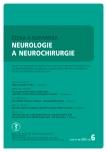Distal Fusiform Aneurysms of the Anterior Temporal Artery – a Case Report
Authors:
V. Přibáň 1; J. Mraček 1; V. Runt 1; F. Šlauf 2
Authors‘ workplace:
LF UK a FN Plzeň
Neurochirurgické oddělení
1; LF UK a FN Plzeň
Klinika zobrazovacích metod
2
Published in:
Cesk Slov Neurol N 2013; 76/109(6): 732-735
Category:
Case Report
Overview
Authors report a rare case of unruptured distal fusiform anterior temporal artery aneurysm in a 63-year-old woman. The only clinical symptom was headache. Correct localization of the aneurysm was revealed using conventional angiography. Aetiology of bacterial infection, vasculitis, and dissection were excluded by clinical and laboratory examinations as well as by visual inspection during surgery. The patient underwent planned surgery. Pterional craniotomy and wide Sylvian fissure dissection was performed and the aneurysm was separated from the circulation with two clips. Vessel patency was confirmed using ICG angiography. With respect to uncertain clinical course of distal anterior temporal aneurysm and possible fatal haemorrhage, the authors recommend using an active approach – separation of the aneurysm from the circulation.
Key words:
intracranial aneurysms – fusiform aneurysms – anterior temporal artery – middle cerebral artery
The authors declare they have no potential conflicts of interest concerning drugs, products, or services used in the study.
The Editorial Board declares that the manuscript met the ICMJE “uniform requirements” for biomedical papers.
Sources
1. Horiuchi T, Tanaka Y, Takasawa H, Murata T, Yako T,Hongo K. Ruptured distal middle cerebral artery aneurysm. J Neurosurg 2004; 100(3): 384 – 388.
2. Umeoka K, Shirokane K, Mizunari T, Kobayashi S, Teramoto A. Dissecting aneurysm of anterior temporal artery – case report. Neurol Med Chir (Tokyo) 2011; 51(11): 777 – 780.
3. Yasargil MG. Microneurosurgery. Vol. II. Stuttgart, New York: Georg Thieme Verlag 1984.
4. Rinne J, Hernesniemi J, Niskanen M, Vapalahti M. Analysis of 561 Patients with 690 Middle Cerebral Artery Aneurysms: Anatomic and Clinical Features As Correlated to Management Outcome. Neurosurgery 1996; 38(1): 2 – 11.
5. Jennet B, Bond M. Assesment of outcome after severe brain damage. Lancet 1975; 1(7905): 480 – 484.
6. Yasargil MG. Microneurosurgery. Vol. I. Stuttgart, New York: Georg Thieme Verlag 1984.
7. Ravena R, Ullova M, Valenzuela F, Yavez A. Microsurgery of the Posterior Cerebral Artery. Rev Chil Neuro‑Psichiatr 2002; 40 : 57 – 68.
8. Haegelen C, Berton E, Darnault P, Morandi X. A revised classification of temporal branches of the posterior cerebral artery. Surg Radiol Anat 2012; 34(5): 385 – 391.
9. Rhoton AL jr. Cranial anatomy and surgical approaches. Schaumburg, IL: Lippincott Williams & Wilkins 2003.
10. Sekhar LN, Stimac D, Bakir A, Rak R. Reconstruction option for complex cerebralartery aneurysms. Neurosurgery 2005; 56 (1 Suppl): 66 – 74.
11. Quiñones ‑ Hinojosa A, Lawton MT. In situ bypass in the management of complex intracranial aneurysms: technique application in 13 patients. Neurosurgery 2005; 57 (1 Suppl): 140 – 145.
12. Ahn JY, Han IB, Joo JY. Aneurysm in the penetrating artery of the distal middle cerebral artery presenting as intracerebral hemorrhage. Acta Neurochir (Wien) 2005; 147(12): 1287 – 1290.
13. Isono M, Abe T, Goda M, Ishii K, Kobayashi H. Middle cerebral artery dissecting aneurysm causing intracerebral hemorrhage 4 years after non‑hemorrhagic onset: A case report. Surg Neurol 2002; 57(5): 346 – 349.
14. Saito A, Fujimura M, Inoue T, Shimizu H, Tominaga T. Lectin‑like oxidized low ‑ density lipoprotein receptor 1 and matrix metalloproteinase expression in ruptured and unruptured multiple dissections of distal middle cerebral artery: case report. Acta Neurochir (Wien) 2010; 152(7): 1235 – 1240.
15. Gibo H, Carver CC, Rhoton AL jr, Lenkey C, Mitchell RJ. Microsurgical anatomy of the distal middle cerebral artery. J Neurosurg 1981; 54(2): 151 – 169.
Labels
Paediatric neurology Neurosurgery NeurologyArticle was published in
Czech and Slovak Neurology and Neurosurgery

2013 Issue 6
- Metamizole vs. Tramadol in Postoperative Analgesia
- Memantine in Dementia Therapy – Current Findings and Possible Future Applications
- Metamizole at a Glance and in Practice – Effective Non-Opioid Analgesic for All Ages
- Advances in the Treatment of Myasthenia Gravis on the Horizon
Most read in this issue
- Frontotemporal Lobar Degeneration from the Perspective of the New Clinical‑ Pathological Correlations
- Tuberous Sclerosis Complex in Children Followed from Neonatal Period for Prenatally Diagnosed Cardiac Rhabdomyoma – Two Case Reports
- Pineal Region Expansions
- Occipital Condyle Fractures
